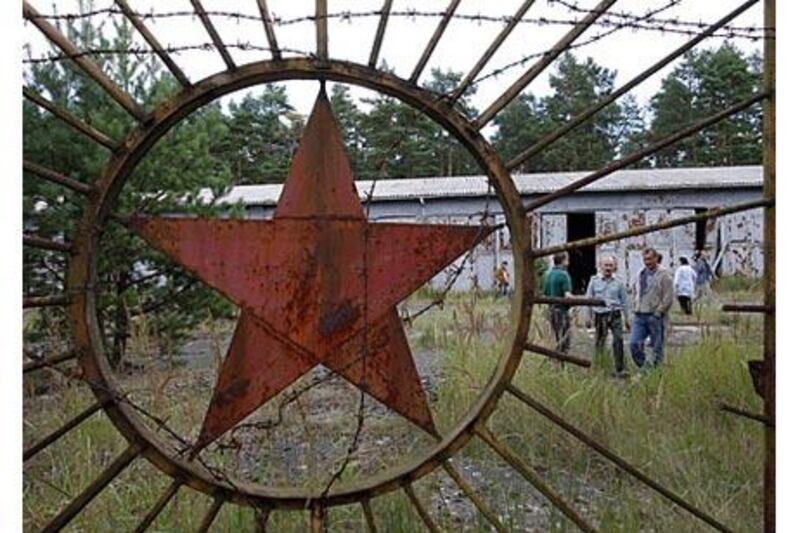FÜRSTENBERG, GERMANY // For sale: one former Soviet nuclear warheads depot, complete with bunkers, 24,000 square metres of derelict buildings and a former shooting range, all in the middle of a scenic German pine forest.
The state of Brandenburg is inviting bids for the 97-hectare site north of Berlin, one of four central storage facilities for atomic weapons in East Germany that would have devastated West Germany if the Cold War nightmare had happened. The warheads, a potential selling point, have been removed. The Soviets whisked them away in the dead of night sometime after the fall of the Berlin Wall in 1989. The site was handed over to the German government in 1992.
The unenviable task of trying to sell the complex, called Lychen II, has fallen to Harald Holland-Nell, manager of property company Brandenburgische Boden BBG, who insists that concerns about contamination are unfounded. "We had a viewing and some 10 potential bidders turned up, but we don't know if any of them will be making an offer," he said in an interview. "The government thoroughly checked all military sites for radiation. It's not as if people dealt with radioactive materials here; the stuff wasn't manufactured at this site. It was just a storage facility."
There used to be guided tours of Lychen II, though they are no longer available. "The gentleman who conducted them has become seriously ill," said a woman in the local tourist office of the nearby town of Fürstenberg. East Germany was a heavily militarised front-line state during the Cold War, and about 550,000 Soviet troops were stationed there after the Second World War. When the Russians left a unified Germany in 1994, and the East German Nationale Volksarmee was disbanded, the federal government was left with vast tracts of military land from the Baltic Sea down to the Czech border, much of it littered with live munitions from army exercises.
The barracks in city centres, which often included such facilities as shops and school buildings, were relatively easy to sell, and in the state of Brandenburg, which surrounds Berlin, about 90 per cent of the 100,000 hectares of military land has been privatised since 1995. The remaining 10,000 hectares includes problems like Lychen II. "It was easier at first; now it's steadily getting harder," Mr Holland-Nell said. "But we have had more difficult cases than Lychen II. We've had to sell properties with former laundries where the ground is contaminated with chemicals."
Relative to its size, Brandenburg has a bigger area of former military land than any of Germany's 16 states. There is more military land in the east because of the heavy Soviet military presence there until the early 1990s. Most of the remaining 10,000 hectares in Brandenburg consists of former military training areas that are heavily contaminated with munitions, and such undesirable installations as deserted, crumbling radar stations located deep in forests.
During the Cold War, Lychen II was a top-secret site hidden behind a wide ring of barbed-wire fences. It was self-sufficient, with residential blocks, canteens, a sport hall and workshops. It boasts 40 buildings, several of which are at risk of collapse after almost two decades of neglect deep in the pine forest. Any buyer would have to commit to tearing down 10 buildings, according to the sale prospectus.
The warheads and detonators were part of the Soviet Union's dreaded arsenal of short-range nuclear missiles. In a crisis they would have been attached to such mobile missile launch systems as the Scud, SS21 or SS23. The two bunkers that held the weapons, made from steel-reinforced concrete, each with 510 square metres of storage halls and guard rooms on two floors, are in pristine condition, but feature asbestos coating at the entrances. KGB officers kept a close watch on the warheads below ground while East German soldiers patrolled above.
Lychen II's main attraction is likely to be the 89 hectares of surrounding forest, filled with wildlife. Any bidder is unlikely to be interested in preserving the depot site. But the sale is stirring controversy. "The bunker is a historic relic of the Soviet occupation after the war and it should be turned into a museum," Lothar Kliesch, the head of the local district council, said. "We could use it to teach tourists and school groups about the nuclear threat under which we all lived in central Europe."
Mr Kliesch said he was concerned the area would be bought by hunters or people intent on harvesting the trees for lumber. "This is the most bizarre sale I've ever seen. The BBG seems to be talking down the value of the site and lowering the price as a result." Mr Holland-Nell said years of talks with an investor about turning Lychen II into a museum had failed. "We're not against using it as a museum, but it has to be a financially viable plan. This place is in the middle of a forest, so you'd need a good concept to get enough people to come out there."
The deadline for bids is Monday. "I can't say what price it will fetch. That will depend on the bids. If I were to cite a price that would influence the bidding process." If no one makes an offer, Mr Holland-Nell will make some changes. "We may have to remove the derelict buildings ourselves; that tends to make sites more attractive. And decent forest is in increasingly short supply. But there's not a lot we can do about the bunker. That will just have to be locked and will remain there for good."
foreign.desk@thenational.ae






